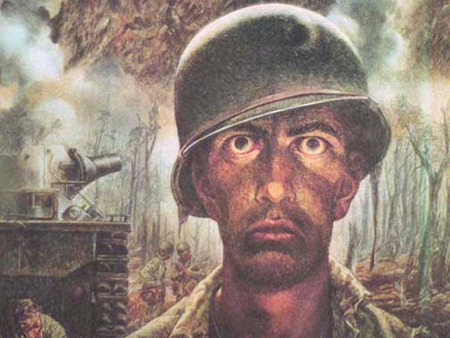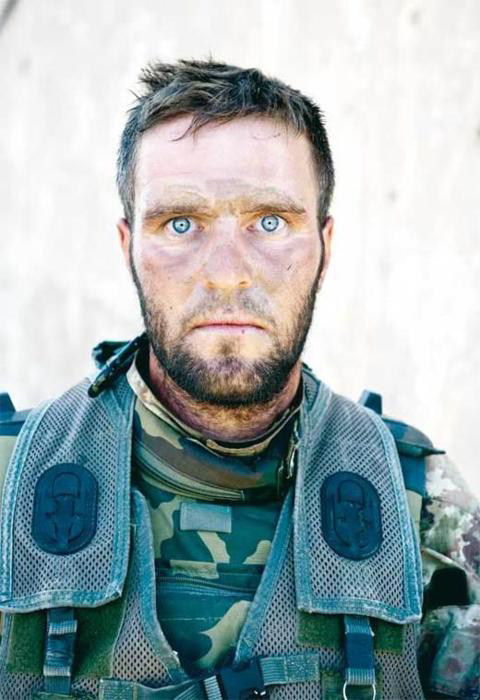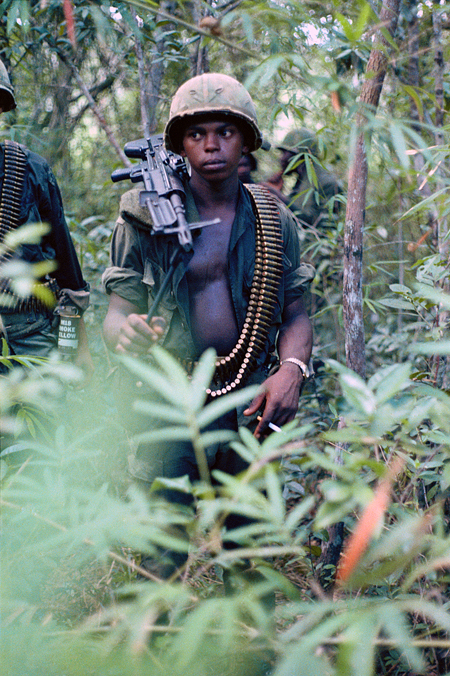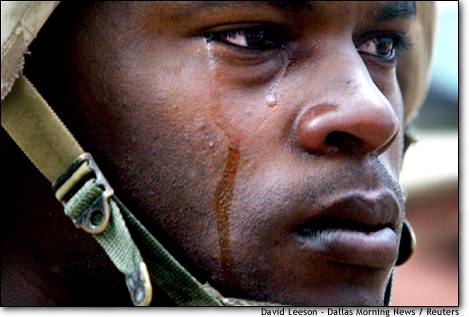The Eyes of the Infantry
The Eyes of the Infantry
Keith Nightingale

The eyes of the Infantry have a different caste than others. They penetrate where others cannot see and they hold images we all wish were not there. They tell the viewer of the soul of the soldier. They are attuned to a primordial focus and see with great clarity what others cannot perceive. They can be wretched, determined, hoping, wishing, fierce, soft or totally blank. They are the ignition mechanism for the body and its continuous operation. This is the face of the experience of war. Once acquired, it never goes away. It may soften but it does not disappear. It will be recast at a passing sound, sight or reflection. The images of moments past well from deep within and cast a clear countenance. It is a look that only some can reflect-those that have been there and done that.

Combat writ large carries a variety of effects on the human. The outside observer may receive a hint from a moment’s conversation but verification quickly comes when the observed eyes suddenly gain a flint-like fix and widen to what might be viewed as almost anatomically impossible. Just as quickly, if in a peaceful environment, they recede into normalcy as a lion might after sating its appetite. Caesar’s Legions had this look as have all combatants who would suppress scenes they saw and cannot forget. Above all, the eyes show commitment.
Fighting as an event means very little but it is the commitment the eyes reflect that the bearers are fighting for that only thing that provides the true import and meaning of the event. For those that carry the eyes, it is the fellow combatants mutual commitment to each other that makes the interpretation of victory or failure. These eyes do not easily surrender because of the mutual commitment shared and strengthened by all. One can kill the vessel but that only further steels the resolve of the others. The eyes require the enemy to surrender, flee or die. There are no other complicated scenarios-the eyes tell it all.

The look, once acquired, is the hidden gift of service that makes all previous actions worthwhile and of value. They hold the images of life on the leading edge and open the door to the deeply recessed vault of events, friendships and moments of peril mutually shared and acquired. People who possess this look have a far different definition of difficult than those that do not. It is the look of Infantry and it remains imbedded to death.
Examine the eyes of the Grunt with the gun. The eyes reflect a dozen on-going simultaneous events. He is curious-What is happening over there? What will they have me do? What is our immediate future? He looks somewhat casual but an examination will show he clearly is not. He has a loose belt already in his gun-he is close to having to use it and wonders in what direction. The OD towel under indicates its favored position but also the sensitivity of choice its owner displays-the towel prevents rust from sweat on the piece-it is a small and obscure point but very telling as to the quality of the bearer. He has the apparent insouciant look of the bored, impatient and irritated soldier. That is a sham as can be discerned from his surroundings and his sweep of view. His gun is immaculate for the location and day’s events. His eyes have insured it is as cleaned as is humanly possible. It is his and his companion’s life and the single most important thing he has ever owned or will—The gun is his and his companions life. It is their Excalibur—to be drawn when needed. The external aspects of the gun speak volumes as to his resolve and dedication. He has seen a great deal as his helmet cover reveals and understands his role. His casual demeanor belies the intimate and arcane knowledge he possesses to operate the piece. He was probably selected to own the piece because he understood its value far exceeded its cost and acted accordingly.

In some quick moment, his eyes will instantly change from wide view to sharply focused through the small rear aperture. The slightly open brushy area to his front will gain all his attention as he methodically works the gun carefully noting the tracer course. His eyes will insure the course is no more than six inches off the ground and in a wide fan. Now his ears in combination with his eyes will coordinate the brain and its commands. The deeper throated enemy weapons are instantly and now instinctually aligned with the gun barrel over the cacophony of the immediate engagement. Within moments, silence will prevail, he will clear his weapon, reattach a belt, wipe the exposed parts with an oily towel, light a cigarette and await the next orders. This is a Grunt and his body at work. There is no color or ethnicity-it is Grunt neutral. But he is anything but neutral. He has become a finely honed machine and always will be. The grit and senses will be suppressed with peace but they will always be present—it is Nature’s way of filling the tank for potential future events.
Combat of too great a length wears and transforms the body to the other images. Only time, peace and mental isolation can return the body and its mind to what we call normalcy. But within, the residue of the eye’s reflection remains to be extracted at odd moments. In some, the stare never leaves and he is judged mentally unstable. But he is just reflecting what he saw when he was considered preternaturally sane and a key cog with his companions and their mutual commitment. The eyes always have it.



